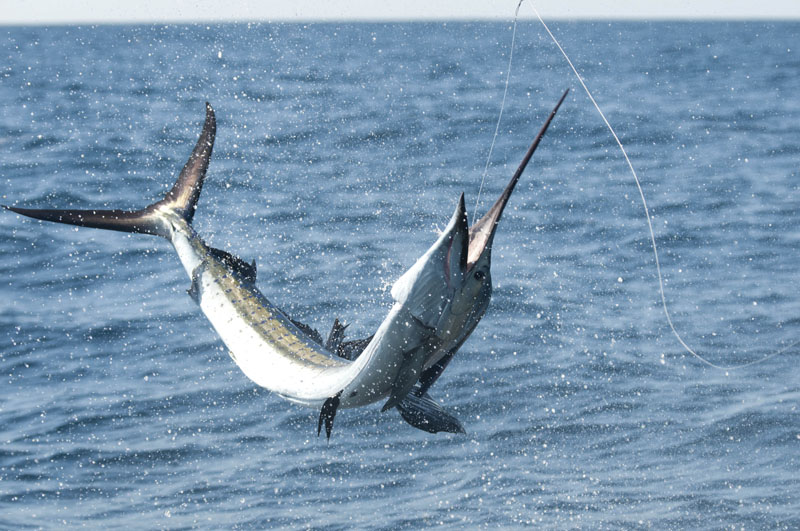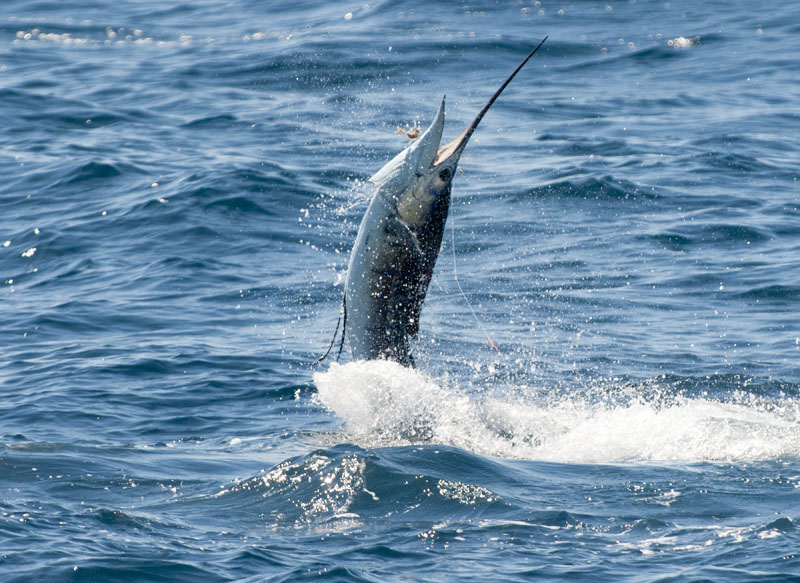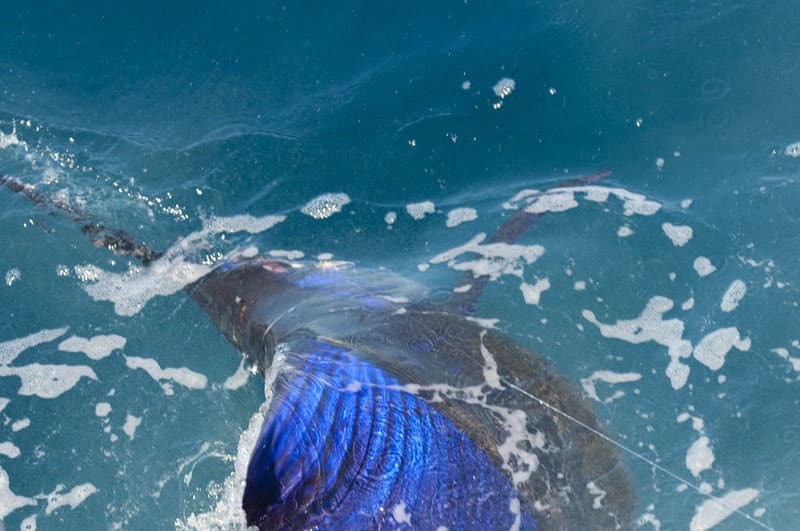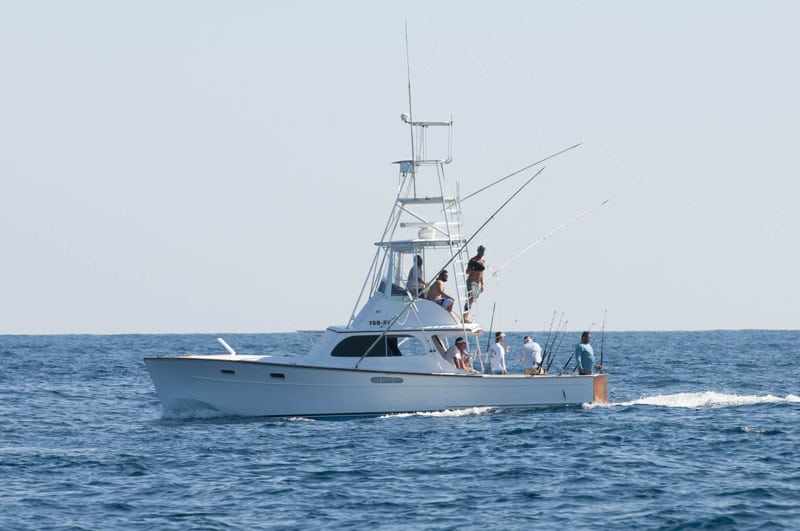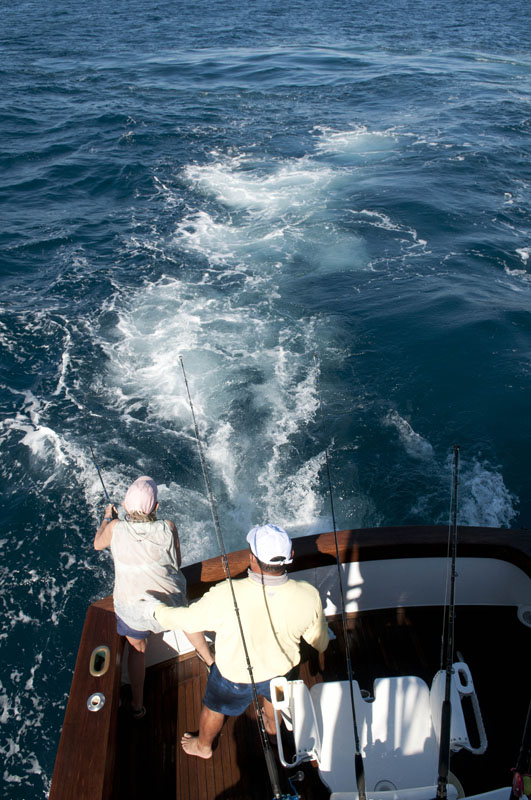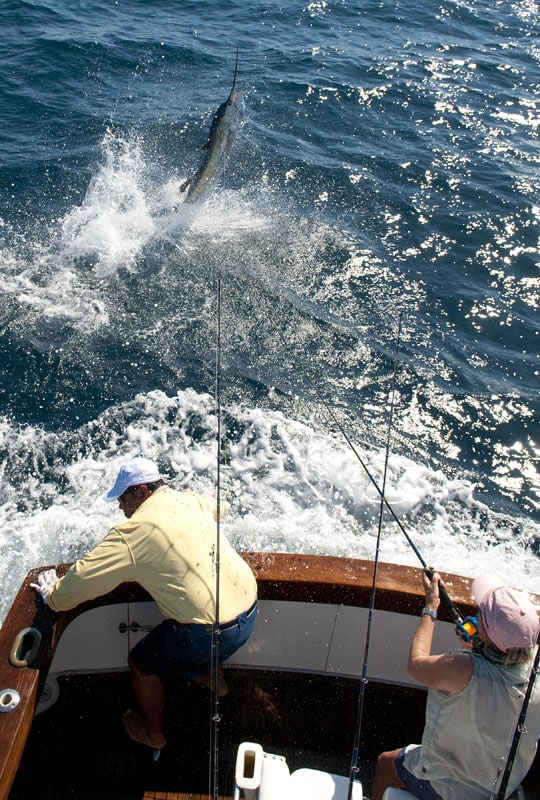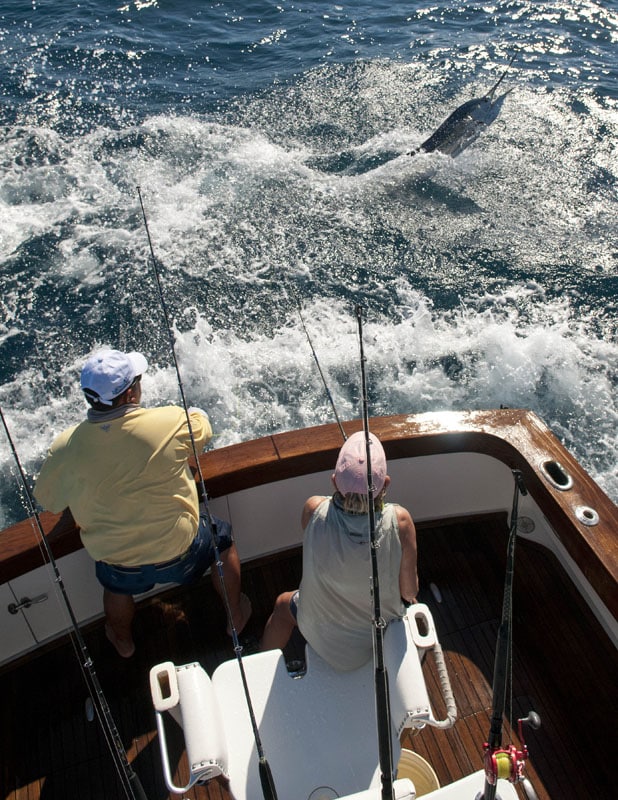
During a recent trip to the Pacific coast of Guatemala, my wife, Poppy, and I enjoyed a day of sailfishing like those experienced by so many others in this incredible area. We were fishing out of Casa Vieja Lodge, and on our first day aboard the Spindrift with Capt. Nicho Alvarenga, we managed to catch and release 25 Pacific sailfish. Other boats caught and released a couple of blue marlin as well. Several boats in the fleet had more sails than us, and a spectacular time was had by everyone who ventured offshore that day.
We caught those sails on 20-pound-test conventional tackle, a standard setup because that size tackle is a good match for the sailfish on the Pacific side, which run larger on average than Atlantic sailfish. But that evening, while discussing the events of the day at the lodge, we hatched a different plan for day two.
Going Light
Alvarenga had another client coming in, so we opted to fish with Capt. Jason Brice, a Miami native who has made a name for himself as one of the top young offshore captains in the world. Brice asked if we’d like to try something new. “Let’s go out tomorrow and try to catch a few on 2-, 4- and 6-pound!” he said with a grin. I had caught Pacific sailfish on tackle as light as 12-pound, but never any lighter. Brice made it sound easy, so we eagerly accepted his offer.
Brice drives the 40-foot Rybovich Makaira for Casa Vieja, and as we climbed aboard the next morning, we noticed something different in the cockpit. Instead of the usual array of 20-pound tackle, with one 50-pound rod kept ready for marlin, the rocket launcher held a group of high-speed Avet reels labeled with tape denoting the size line they held. The big marlin rod was still there, in case a 500-pounder materialized in the wake.
“One key to light-tackle billfishing is to use small high-speed conventional reels,” Brice said. “We are using Avet SX5.3:1 reels mounted on custom 61/2-foot ultralight Biscayne rods. It’s critical to make sure your drags are silky smooth. You have to know exactly what your full drag pressure is in relation to your strike setting.”
There He Is
After running offshore, Brice slowed the boat, and his two mates deployed their typical light-tackle spread. They put out four teasers, two run from the bridge and two from the cockpit, with no hook baits. The teasers had been out only a few minutes when the two mates pointed into the wake and screamed, “mar-LEEN!”
A striped marlin had appeared without warning and was now locked onto the left cockpit teaser, only a few feet behind the transom. I instinctively reached for the large marlin rod, but Brice shouted from the bridge, “No! Screw it, toss the 8-pound at him, Poppy! Do it now!”
Poppy grabbed the outfit marked 8 and pitched the sewn ballyhoo bait over the transom. Brice slowed the boat as the mate began retrieving the teaser, and in a flash, the striper piled on the bait but missed it. It disappeared into the wake and never reappeared.
The whole affair lasted maybe 25 seconds, but I can tell you firsthand that it was among the most intense 25 seconds I’ve ever experienced. “Now that was cool!” Brice exclaimed as we all nodded in agreement. “Let’s go find another one.” The mates reset the teasers, and Brice throttled the boat back up to trolling speed.
The Sails Show Up
We initially had decided to start with 4-pound and work our way up, but in cool retrospect, we decided it might be more prudent to start with 12- or 8-pound and work our way lighter. While we debated what to start with, a sailfish popped up behind the right long teaser, prompting an immediate decision.
I grabbed the rod closest to me and dropped back. I had picked up a 12-pound outfit, and as the sailfish engulfed the bait, I threw the reel into strike. By the time the fish came tight and began to jump, Brice already had the Rybovich in reverse and was backing down hard.
The fish jumped repeatedly but never got far from the boat, as Brice expertly maneuvered it to stay close. Since 12 is not particularly light line, I was able to put considerable pressure on the fish, and the mate soon had the leader in hand. A few quick in-the-water photos later, and the sailfish was cut free.
Survive the Bite
We decided to put the 12-pound away and drop next to 8, and as we waited for another fish to rise, I asked Brice about his thoughts on boat handling during the fight. “The shorter the fight, the better,” Brice said. “Just like when we are fly-fishing, we slow the boat down as the fish is teasing up. With 2- and 4-pound, I want to be in neutral or even reverse during the bite so, if and when that fish turns, you have a chance of staying connected. The key is to survive the bite.
“On 2-pound, if he turns, you’re done,” Brice continued. “You want him to be coming at you when he eats the bait. On 4-pound, you’d better be on him if he turns. With 6- and 8-pound, it’s nice to have a head start when backing down on him, but not as crucial. You can actually get down-and-dirty with 6 and 8 if he goes down on you. But since there is not much pressure on the fish with the light line, they tend to stay on top and zip around.
“The main thing is to keep as little distance between you and the fish as possible.”
Sail on 8
A short while later, another sailfish popped up, and this time, Poppy dropped back on 8-pound. The fish took the bait in classic form, and just as he’d described, Brice was already bringing the boat back as the fish leapt away after feeling the sting of the circle hook. The sailfish made a series of spectacular jumps only a few feet from the transom, and we were able to get the release in very short order. It was one of the most exciting fights I’ve ever witnessed, all quite close to the boat.
After Poppy’s release on 8, I caught and released one on 8 as well. Each time, Brice kept the fish very close through aggressive boat handling. Then it was time for 6-pound. Once again, we hadn’t trolled far when a sailfish appeared. I dropped back, the fish took the ballyhoo, and the fight was on.
With each progressive reduction in line strength, we had to modify our tactics slightly. When the fish got a little ways away from the boat, we would back off slightly on the drag. When the fish was tired and docile close to the boat, we would push the drag slightly beyond strike to gain advantage toward the endgame and get the release. It’s key to know where the drag is at all times and be ready to loosen it if the fish makes a sudden surge.
Four on 6
The next hour was a blur of activity, and Poppy and I each managed to release two fish on 6-pound. We got around to the 4-pound-test in the afternoon, but as luck would have it, we didn’t raise another billfish. We headed home late in the day with a new appreciation for these great fish and a renewed commitment to keep the heavier tackle stowed and pull out the light stuff instead.
Rest assured, the next time I venture to a spot like Guatemala, where the shots often come fast and furious, you’ll see me with light tackle in my hands.
TRIP PLANNER
The techniques described here will obviously work anywhere, but you stand a better chance of scoring with light gear when fishing in a place with a lot of fish. By using smaller rods and high-speed conventional reels with super-smooth drags, combined with coordinated boat handling, you raise your chances of success immeasurably.
Rods: Light conventional rods with smooth guides and sensitive tips. The rods must be able to apply some pressure if a fish sounds.
Reels: Small high-ratio conventional reels with silky smooth drags, like the Avet SX5.3:1.
Lines: 2- to 8-pound nylon monofilament.
Leaders: Nylon or fluorocarbon monofilament to suit, from 40-pound and up for sailfish to 250-pound-test for marlin. Shorter leaders offer less water resistance during the fight but also offer less protection from breakage.
Baits: Sewn ballyhoo rigged naked on circle hooks.
Hooks: Thin-wire circle hooks for maximum penetration on light tackle. Brice uses 7/0 Eagle Claw L2004 hooks.
There’s no better place to give this a shot than Guatemala, although you can try it anywhere the fish are cooperative.
What: Light-tackle billfishing.
**
When:** Prime season is December through June.
**
Where:** The Pacific coast of Guatemala.
**
Who:**
Casa Vieja Lodge
800-882-4665
www.casaviejalodge.com
